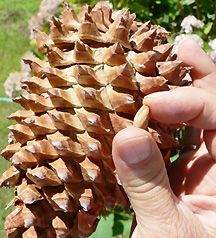Chesapeake Bay's Independent Newspaper ~ Since 1993
1629 Forest Drive, Annapolis, MD 21403 ~ 410-626-9888
Volume XVII, Issue 51 ~ December 17 - December 23, 2009
Home \\ Correspondence \\ from the Editor \\ Submit a Letter \\ Classifieds \\ Contact Us
Dining Guide \\ Home & Garden Guide \\ Archives \\ Distribution Locations \\ Advertising
![]()


The Bay Gardener
 by Dr. Frank Gouin |
The Secret Life of Cones
Why you’re unlikely to grow your
Christmas tree from seed
Cones of pines, spruce and fir are very popular in fall and winter. Children are fascinated by their shape and texture, many hobbyists use them in their creations, campers use them for starting campfires and bird lovers coat them with peanut butter and suet to feed the birds.
Look closely and you may wonder why cones don’t have any seeds.

![]() Cones open in late summer or early fall while still on the tree, and the seeds are scattered by the wind. The winged seeds that rise from cones are called samaras. Thus, if you are going to collect seeds, you must climb the trees and collect cones while they are closed. However, if you collect the cones before they turn brown, the seeds will not be mature. So you must watch the cones closely as they turn from green to brown.
Cones open in late summer or early fall while still on the tree, and the seeds are scattered by the wind. The winged seeds that rise from cones are called samaras. Thus, if you are going to collect seeds, you must climb the trees and collect cones while they are closed. However, if you collect the cones before they turn brown, the seeds will not be mature. So you must watch the cones closely as they turn from green to brown.
Cones that are just maturing are difficult to free from branches. They are also covered with pitch. Commercial harvesters generally use long-pole pruners and cut the cones from the branches. After the cones are collected, they are placed on screen-bottomed shelves in a warm room with temperatures maintained at 85 to 90 degrees. The high temperatures are necessary for obtaining a lower humidity to dry the cones and make the pitch brittle. In three to five weeks, the cones begin opening and mature seeds will fall from them. As soon as the cones fully open, the seeds are collected and placed in cold storage in preparation for fall planting. Seeds from coniferous trees are very small.
In mid-November the seeds are scattered on a well-prepared seedbed. The seeds are sown in close proximity, about five seeds per square inch, since only about half will germinate in the spring. The seeds are then covered with a half-inch layer of a 1:1 mixture of sand and peat moss. The cover mixture is topped with a thin layer of straw or pine needles to prevent rains from washing the seeds from the ground. In the spring the straw or pine needles are removed before the seeds begin germinating.
Too Late to Move Azaleas
Q A previous homeowner planted a bank of azaleas over 15 years ago. They have never been pruned back and are placed too close together, plus one end of the bank is getting overwhelmed by an equally vigorous rhododendron.
I was planning on a vigorous springtime pruning as you have suggested in your column, but I also wondered how well a few would take to being transplanted right now. Are azaleas hardy enough to withstand excavation and re-planting? I assume the root ball will be pretty sizable. These are tall and leggy plants, happy but crowded, and I don’t know how gentle I can be getting them out of the ground in such crowded conditions.
Along the same lines, can rhododendron be pruned in the spring same as the azaleas?
–Howard Wellman, via email
A You must have missed reading one of my Bay Gardener articles that recommended transplanting azaleas in August or early September. That is the best time of year. Transplanting them now will most likely result in losses and poor growth. When transplanting azaleas, do not prune back the tops until about one year later. You need all those branches to help the plant generate new roots. The hormones that generate new roots are produced in the buds of the branches.
Ask Dr. Gouin your questions at [email protected]. All questions will appear in Bay Weekly. Please include your name and address.
© COPYRIGHT 2009 by New Bay Enterprises, Inc. All rights reserved.